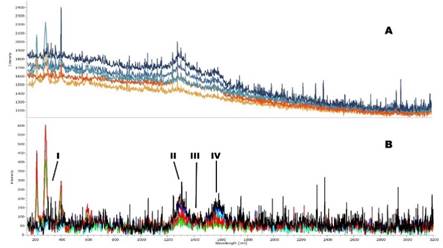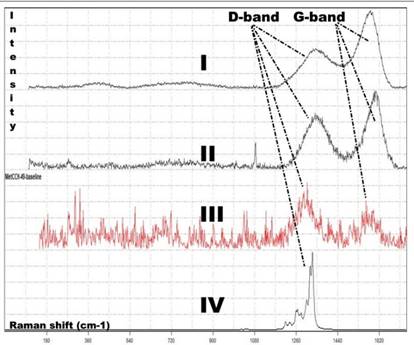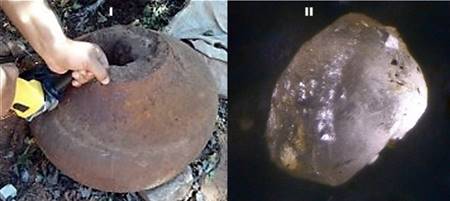INTRODUCTION
The variable bonding nature of carbon-carbon bonds gives rise to materials with widely different properties ranging from semi-metallic graphite to the wide-bandgap insulator diamond. Diamond is the hardest known material formed by sp3-bonded layers arranged in a cubic stacking arrangement. Another sp3-bonded allotrope with hexagonal layer stacking was proposed based on additional broad diffraction features reported from samples prepared by static and dynamic compression of graphite. Analogous patterns were also observed from hard carbon materials extracted from the Canyon Diablo iron and Goalpara ureilite meteorites and assigned to lonsdaleite (Comments in 1).
The identification of lonsdaleite in hard carbon-type materials was based on X-ray diffraction (XRD) patterns. The XRD results were later complemented by transmission electron microscopy (TEM) and electron diffraction results, and Raman spectroscopic data, leading to the widely accepted conclusion that the pure hexagonal diamond structure had been identified and was present among natural and synthetic samples (1 and references). But Raman scattering is known to be more sensitive to structure crystallinity than X-ray diffraction 2.
Lonsdaleite (also called hexagonal diamond, polytype 2H), is a physical mixture (not simple) of cubic (3C) and hexagonal diamond; it is structurally best described as a stacking disordered diamond 2;3;4;1. In this work to follow this mixture of a hexagonal and cubic diamond will be referred to as a lonsdaleitic diamond.
Around 70 km SSE of Chovoreca Hill (Paraguay), a lonsdaleitic diamond-like bearing a pitcher-shaped metal piece (which in what follows will be referred to as METCCH) weighing approximately 303 kg was studied by SEM/EDS and Raman Spectroscopy by 5. Following is a very brief review of the Raman spectra obtained by 5 to more fully signify that such diamond-like crystal (which in what follows will be referred to as METCCH diamonds) is truly lonsdaleitic diamonds and we provide more evidence that the metallic fragment is a meteorite.
METHODOLOGY
(5 Using Raman equipment of FaCEN (UNA) Laboratory, analyzed by Raman Spectroscopy individual grains of METCCH diamonds (0,1-1 mm). The RAW eight different Raman spectra obtained by 5 in this work, for a revisit, were processed using the two open-source software. CrystalSleuth was used to remove the background noise for enabling the comparison of multiple spectra and Spectragryph was used for deriving individual peak values, full width at half maximum (FWHM) calculation, and Gaussian deconvolution of the spectrums.
RESULTS AND DISCUSSION
The first-order Raman spectrum, in the defect-free (or undisturbed lattice) cubic natural diamonds, consists of a single narrow Lorentzian-shaped peak wavenumber at 1332.5 cm−1 (4 × 1013 Hz, 165 meV), with FWHM of ~1.5-3 cm−1 (2;6;7;8;9;10;11;12; and any shift to either higher or lower than this wavenumber would have genetic implications (cf. 2;3;10;12;13;14;15. Raman spectra peak wavenumber = 1332.4 cm-1 is for a natural diamond for 12C rich fraction and decreases to 1282 cm−1 for a highly enriched 13C (for example 16 and so as, 17 and references). As well as found in 17 the dependence of the first-order Raman peak wavenumber on temperature (Low values are obtained at high temperatures). In impact diamonds, the FWHM increases as a function of the lonsdaleite content 9;2. As well as the FWHM in the diamonds increases with increasing pressure 16. So too, 17 comments on the dependence of the diamond FWHM on temperature (large values are obtained at high temperatures).
Figure 1A shows five of the most representative RAW Raman spectra obtained by 5 in METCCH diamonds. Figure 1B individualizes the most characteristic peaks area or bands (baseline spectra) of the same in Figure 1A of METCCH diamonds Raman spectra; i.e., I-Iron meteorite-band, II- D-band (diamond), and IV- G-band (graphite). Between D and G bands individualizing even the III- low-quality diamonds band.

Figure 1 Raw Raman spectra (as in 5) of METCCH diamonds and B baseline the same Raman spectra. I kamacite-taenite-plessite (Iron meteorite)-band (as in 29); II D-band; III poor quality D-bad; and IV G-band. D: Diamond
Figure 2 is a zoom of Figure 1B in the iron meteorite band, where it can be seen that the peaks are different from those of hematite Raman spectra (used for comparison), thus evidencing that the METCCH diamonds would have formed in an iron meteorite environment.

Figure 2 Peaks of Iron meteorite-band compare com hematite peak (RRUFF database), in the METCCH-diamond Raman spectra. The Iron meteorite-band Raman spectrum in METCCH is well representative; the spectrum is quite different from that of hematite.
The lonsdaleitic diamond or the stacking disordered Popigai-like impact diamond has the most characteristic Raman shifts wavenumber: 1320-1328 cm-1 (18; or 1292-1303 cm-1 (strong) and 1244-1219 cm-1 (weakly) as from 9 and so as, 19. In the D-band of the METCCH diamonds stand out the peaks wavenumber, from edited baseline data: METCCH-15 1300.7 cm-1 with FWHM 99.7 cm-1; METCCH-17 1325.7 cm-1 with FWHM 81.92 cm-1; METCCH-21 1328.8 cm-1 with FWHM 39.29 cm-1; METCCH-22 1304.9 cm-1 with FWHM 110.87 cm-1; METCCH-29 1327.6 cm-1 with FWHM low; METCCH-43 1294.6 cm-1 with FWHM 148.92 cm-1; METCCH-48 1300.2 cm-1 with FWHM 162.98 cm-1; and METCCH-49 1302.9 cm-1 with FWHM 113.55 cm-1 (Table 1). That is, the D peaks of the METCCH diamonds show shifted values lower than the typical defect-free diamond peak wavenumber; ~1295 to ~1329 cm-1 so that the characteristic Raman band of lonsdaleitic diamonds between 1200-1400 cm−1 region delimitated by 18. It registered the most intense D-band peaks wavenumber in METCCH-15 and METCCH-49; while the lowest peaks wavenumber in METCCH-21, METCCH-29, and METCCH-43. The FWHM read in METCCH diamonds varied from 39.29 cm-1 (METCCH-21) to 162.98 cm-1 (METCCH-49); that is, extremely high FWHM values (Table 1, see also 5) concerning the typical defect-free diamond; and as the values registering in Popigai lonsdaleitic diamonds 4; meteorite impact diamonds (for example, 20); and so, as detonation impact diamonds (cf. 21); among other artificially created diamonds. Figure 3 and Table 1 show the zone of the D-band, G-band, and between both the low-quality diamonds band obtained for METCCH diamonds. METCCH-diamonds D-band is compared with the Popigai lonsdaleitic diamond Raman spectra.

Figure 3 METCCH-diamonds peak wavenumber in D-band (I, around 1308 cm-1) II (around 1450 cm-1), poor quality D-band; and III (around 1560-1590 cm-1) G-band compare with Popigai lonsdaleitic diamond (data from 4). D-band is an asymmetrical band from METCCH-diamonds and so as the Popigai lonsdaleitic diamond.
| ID | A-Raman shift [cm-1] | intensity | FWHM [cm-1] | B- Raman shift [cm-1] | intensity | FWHM [cm-1] | C- Raman shift [cm-1] | intensity | FWHM [cm-1] |
|---|---|---|---|---|---|---|---|---|---|
| 1-MetCCH-15 Raw | 1282.5 | 1825.5 | 71.356 32% Lons. | 1547.1 | 1585.6 | ||||
| MetCCH-15 baseline | 1282.5 | 250.59 | 4.3021 | 1428.2 | 99.81 | 3.1002 | 1585.7 | 125.06 | 23.597 |
| MetCCH-15 smoothed | 1300.7 | 107.51 | 99.718 | 1581.3 | 66.772 | 115.73 | |||
| MetCCH-15 Gaussian | 1308.4 | 226 | 143.16 | 1589.8 | 202.45 | 8.1648 | |||
| 2-MetCCH-17 | 1282 | 1531.2 | 1427.7 | 1472.3 | 76.676 | 1548.7 | 1400.7 | 71.692 | |
| MetCCH-17 | 1282 | 169.97 | 3.7031 | 1427.7 | 130.65 | 2.1165 | 1625.9 | 112.6 | 3.7281 |
| MetCCH-17 | 1325.7 | 45.978 | 81.92 35% Lons. | 1429 | 37.365 | 1523.7 | 37.032 | ||
| MetCCH-17 | 1336.9 | 143.17 | 38.203 | 1451 | 126.47 | 24.446 | 1588.9 | 116.96 | 70.111 |
| 3-MetCCH-21 | 1428 | 1311.9 | 143.79 | 1585.8 | 1309.6 | 79.296 | |||
| MetCCH-21 | 1451.5 | 39.249 | 7.3085 | 1585.1 | 65.972 | 2.6353 | |||
| MetCCH-21 | 1328.8 | 3.7073 | 39.294 10% Lons. | 1434 | 40.228 | 1546.4 | 29.541 | ||
| MetCCH-21 | 1309.8 | 82.997 | 46.353 | 1565 | 67.675 | 33.079 | |||
| MetCCH-22 | 1282.5 | 1690.9 | 42.357 11% Lons. | 1554.5 | 1490.8 | 132.03 | |||
| 4-MetCCH-22 | 1282.5 | 209.77 | 4.6184 | 1585.4 | 101.56 | 55.82 | |||
| MetCCH-22 | 1304.9 | 87.343 | 110.87 | 1568.2 | 52.087 | 134.72 | |||
| MetCCH-22 | 1309.7 | 139.61 | 72.529 | 1565 | 115.7 | 86.148 | |||
| 5-MetCCH-29 | 1282.6 | 1410.9 | 0% Lons. | 1585.7 | 1309.6 | 65.289 | |||
| MetCCH-29 | 1282.6 | 190.11 | 2.6087 | 1428.4 | 84.734 | 3.6406 | 1585.7 | 103.44 | 3.2183 |
| MetCCH-29 | 1327.6 | 30.282 | 1429.6 | 34.481 | |||||
| MetCCH-29 | 1418.9 | 189.48 | 1565.6 | 197.39 | |||||
| 6-MetCCH-43 | 1282.2 | 1543.6 | 1584.8 | 1390.6 | 91426 | ||||
| MetCCH-43 | 1362.5 | 141.42 | 4.5854 | 1462.4 | 152.34 | 20.91 | 1576.8 | 189.87 | 2.4262 |
| MetCCH-43 | 1294.6 | 54.551 | 148.92 100% Lons. | 1560.7 | 40.107 | ||||
| MetCCH-43 | 1286.2 | 186.77 | 1417.9 | 174 | |||||
| 7-MetCCH-48 | 1282.4 | 1657.5 | 1427.4 | 1543.1 | |||||
| MetCCH-48 | 1282.5 | 160.85 | 3.2365 | 1427.4 | 80.911 | 3.4579 | 1554.8 | 81.695 | 2.9191 |
| MetCCH-48 | 1300.2 | 85.238 | 162.98 100% Lons. | 1583.3 | 52.737 | ||||
| MetCCH-48 | 1309.7 | 234.77 | 1560.8 | 199.96 | |||||
| 8-MetCCH-49 | 1282.5 | 1964.6 | 1427.8 | 1760.3 | 1585.2 | 1702.1 | 104.52 | ||
| MetCCH-49 | 1282.5 | 300.93 | 4.5275 | 1427.9 | 138.43 | 2.8627 | 1585.3 | 171.34 | 28.041 |
| MetCCH-49 | 1302.9 | 137.97 | 113.55 63% Lons. | 1584 | 90.354 | 122.2 | |||
| MetCCH-49 | 1285.4 | 193.17 | 89.846 | 1589.4 | 134.63 | 85.251 |
Table 1. Raman spectroscopy characteristics of the 8 crystals published in 5. A D-band peak; B, a poor-quality diamond band (or diamond with having compressive stress band), and, C, G-band; all with the peak wavenumber. peak intensity and FWHM values. They are represented according to 4 different forms of edition: Raw data; baseline data; smoothed data; and, Gaussian deconvolution data. The data that have been used in this writing are in shaded boxes. Lons. = lonsdaleite; measured according to Raw (more own) or smoothed FWHM values. 5-MetCCH-29 only diamond?
According to the expressions of (17; and references), 16, and 15 and considering that the D-band peaks and FWHM values in METCCH-diamonds (Table 1), it could be assumed that they would have formed under conditions of high temperature and also high pressure.
The type of D-band and its peaks wavenumber together with the extremely high FWHM values undoubtedly reveal that the METCCH-diamonds would be lonsdaleitic diamonds 5 which, according to what was deduced from the work of 2, are diamonds with 10 to probable 100% of tenors of lonsdaleite (values obtained by adjustments presented in 22); it is understood that much high than the (undisturbed lattice) natural diamond.
G-band in the METCCH-diamonds were recorded with peaks wavenumber (baseline records) between 1583 cm-1 and 1588 cm-1 at METCCH-15 (strong), METCCH-17 (low), METCCH-21 (low), METCCH-43 (strong), METCCH-48 (strong) and METCCH-49 (very strong); where in METCCH-29 is not registered. Thus, it is interpreted that METCCH diamonds would have been formed from graphite, which 5 indicated to be abundant in METCCH.
The poor-quality D-band (baseline records) peaks wavenumber registered in METCCH-diamonds range between 1427 cm-1 and 1462 cm-1 in all METCCH-diamonds except METCCH-22 which we do not register. The poor quality D-band (or low crystallinity artificial diamond band of https://www.nanophoton.net/applications/minerals/wide-field; or diamond with having compressive stress of 23) is most recognized by 12;24 as characteristically displayed by defect-bearing diamonds (disordered diamonds); and also disorder peak observed in cracked regions of natural diamonds which have undergone a pressure of 300 GPa 7.
Finally, Figure 4 compares similar Raman spectra profiles of impact diamonds (lonsdaleitic diamond) from MAPCIS impact basin (Musgrave, 24), lamprotic lonsdaleitic diamond (Capiibary, Capii-6-29, 22), and METCCH-diamond. These three lonsdaleitic diamonds show wide and intense peaks in the D-band and G-band; that is, METCCH-diamonds show an identical 3 Raman band of lonsdaleitic diamond (1200-1400 cm−1 in 18) with which they were compared. Also, they are compared to Popigai's lonsdaleitic diamond 4. Architecture or “diamond line” of the Raman spectrum between D-band and G-band that are similar to those recorded for example in nanodiamonds produced by detonation (cf. 25).

Figure 4 D-band and G-band in the Raman spectra of I, Musgrave; II, Capiibary Capii-6-29 lonsdaleitic diamond; III, METCCH-diamond and IV, Popigai impact diamond.
To investigate the formation temperature of the METCCH-diamonds the calculation formula of 26, based on the peak of the G band, was applied (baseline mode data without correction and so they are for reference data only) to well-selected grains (5 Raman spectra showing the G band ~1580 cm-1). The maximum formation temperature obtained oscillates between 1068°-1541°C (Table 2).
| MetCCH | FWHM | T °C | Peak-G cm-1 |
|---|---|---|---|
| MetCCH-15 | 8 | 1435 | 1567,3 |
| MetCCH-17 | 2,16 | 1551 | 1554,5 |
| MetCCH-18 | 2,66 | 1541 | 1584,8 |
| MetCCH-21 | 5,58 | 1482 | 1585,4 |
| MetCCH-22 | 9,73 | 1401 | 1563,2 |
| MetCCH-29 | 3,22 | 1529 | 1585,7 |
| MetCCH-43 | 2,66 | 1541 | 1584,8 |
| MetCCH-48 | 2,92 | 1535 | 1554,8 |
| MetCCH-49 | 28,04 | 1068 | 1585,3 |
Table 2. The formation temperature of the METCCH-diamonds analyzed from the FWHM obtained from peaks in the G band (graphite) based on the formula of 26.
CONCLUSION
A very probable lonsdaleitic diamond bearing a pitcher-shaped metal piece weighing approximately 303 kg was studied by 5 SEM/EDS and Raman Spectroscopy methods. In this work, we revisited the very probable lonsdaleitic diamond Raman spectra data (eight METCCH-diamonds Raman spectra) produced by 5. Revisited to produce refined data that allow strong support for the interpretation of diamond-like crystals and the origin of the piece of the metal host of the diamond-like materials.
Raman spectra of METCCH-diamonds characteristically show 3 intense bands: D-band (with peaks wavenumber in 1294 to 1330 cm-1), G-Band (with peaks wavenumber in 1583 to 1588 cm-1), and in some samples Raman spectra of the iron-meteorite band (with peaks wavenumber in 217, 284 and 402 cm-1) (Figure 1). Between the D-band and G-band identifying the 4th band, is not very intense (peaks wavenumber in 1428 to 1460 cm-1) now in typical low-quality diamonds or disordered diamonds (Figure 1).
METCCH-diamonds display a D-band peak wavenumber typically (Figure 3) as seen in lonsdaleitic diamonds; i.e., shifted at values than the wavenumber peak of undisturbed natural diamond. So, also METCC- diamonds show FWHM values (Table 1) from large to very large like lonsdaleite diamonds. Thus, from the point of view of Raman spectroscopy, METCCH-diamonds are lonsdaleitic diamonds.
The shifted values observed in the D-peak wavenumber in METCCH lonsdaleitic diamonds as lower than the wavenumber peak of undisturbed natural diamond and METCCH lonsdaleitic diamonds with strong to very strong FWHM values (Table 1) suggest that they would have formed at high temperatures.
The strong to very strong FWHM in METCCH lonsdaleitic diamonds (Table 1) suggest 10 to probable 100% of tenors of lonsdaleite; i.e., would have formed at very high pressures; as previously interpreted by 5. The very high-pressure formation of METCCH lonsdaleitic diamonds may also be supported by a disorder peak (~1450 cm-1) that develops in regions of natural diamonds that have undergone a pressure of 300 GPa (cf. 16 and 7).
The formation temperature of the METCCH-diamonds analyzed from the FWHM obtained from peaks in the G band (graphite) reached 1068°-1541°C; temperatures close to those recorded in graphite from meteorites with impact diamonds by 27 and so as by 28.
The presence of the iron-meteorite zone recorded in some METCCH lonsdaleite diamonds Raman spectra (Figure 2) suggests that they definitely would have formed in an iron meteorite; i.e., METCCH is a lonsdaleite diamond bearing iron meteorite rich in graphite as reported by 5. Thus, METCCH joins the rare lonsdaleitic diamonds-bearing iron meteorites so far recorded (for example, Canyon Diablo meteorite; 1 and references), yet METCCH could at the same time be seen as the largest lonsdaleitic diamond-bearing iron meteorite ever recorded (Figure 5).












 uBio
uBio 



